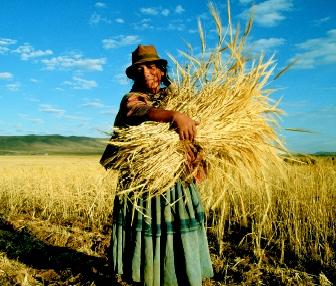Humans depend on water in many ways, well beyond the few liters needed daily for drinking. Water is also essential for the production of food. Various forms of agriculture, practiced on about half of Earth’s land surface, provide the vast majority of food that over 6 billion people eat. Agriculture also provides much of the fiber for cotton, wool, and linen clothing.
Rain-fed Agriculture
One of the primary ways in which humans use water is by planting important crops in places where they can capture natural rainfall as rain-fed agriculture. Some forms of agriculture, such as intensive rice and corn production, can be practiced only in rainy climates. Such agricultural forms are much more productive than others, such as cattle and sheep herding, which are usually relegated to semiarid climates.
One of the primary reasons rain-dependent forms of agriculture are more productive than dry-land forms is that they have sufficient water to allow plants to grow to their maximum potential. Therefore, the most agriculturally productive regions of the world are all regions where natural rainfall is sufficient to allow rain-fed agriculture to flourish:
for example, the Subsistence agriculture on small farm plots is practiced in the highly elevated Altiplano of Chile and Bolivia (South America). Farmers in the arid highlands must cope with the variable weather conditions and extreme climatic uncertainty.
eastern and central United States; the Pampas of Argentina; central Europe; northern and eastern India and Bangladesh; eastern China; and the valleys and volcanic islands of southeast Asia.
Up to a point, the more rain, the more productive the crops. For example, in the United States, corn is a productive grain that typically yields over 100 bushels per acre, but requires a climate where rainfall is at least 76 centimeters (30 inches) per year. Wheat yields only about 20 bushels per acre under the same conditions, but can still yield nearly this much if rainfall is only 50 centimeters (20 inches). Therefore, farmlands that receive at least 76 centimeters (30 inches) per year, as they do in the Corn Belt states of Ohio, Indiana, Illinois, and Iowa, are much more agriculturally productive than the Wheat Belt lands of the Dakotas, Montana, Nebraska, and Kansas, which receive less than 76 centimeters (30 inches). And the monsoonblessed rice lands of southeast Asia are more productive yet.


